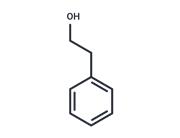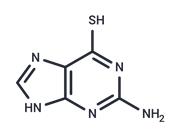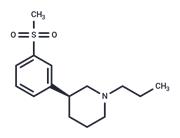| Name | LIT927 |
| Description | LIT927 (LIT-927) is an orally active CXCL12 neutraligand (Ki: 267 nM for CXCL12 binding to CXCR4). |
| Cell Research | HEK EGFP-CXCR4-expressing cells were washed with phosphate-buffered saline (PBS) and detached in PBS-EDTA (5 mM) for 2 min at room temperature. Then cells were carefully resuspended in complete growth medium, pelleted by centrifugation at 320 × g for 5 min, and resuspended in HEPES buffer (137.5 mM NaCl, 6 mM KCl, 1.25 mM CaCl2, 1.25 mM MgCl2, 0.4 mM NaH2PO4, 5.6 mM glucose, 10 mM HEPES (pH 7.4) containing 0.1% BSA. Cells were used at a concentration of 10^6 cells/mL, then the cell suspension (1 mL) was transferred into a quartz cuvette. Time-based recordings of the fluorescence emitted at 510 nm (excitation at 470 nm) were performed at 21 °C using a Fluorolog 3 spectrofluorometer. Fluorescence binding measurements were initiated by adding at t = 150 s, 100 nM CXCL12-Texas Red (TR) to the 1 mL cell suspension. Binding of CXCL12-TR to EGFP-labeled CXCR4 was detected as a reversible decline of emission at 510 nm due to energy transfer from excited EGFP to TR. In the "neutraligand protocol", CXCL12-TR was preincubated for 1 h at room temperature with DMSO or various concentrations of each test compound. Then the premix was added (at t = 150 s), and fluorescence was recorded until equilibrium was reached (300 s). In the "antagonist protocol", DMSO or various concentrations of each test compound were added to EGFP-CXCR4-expressing cells at t = 50 s. Then CXCL12-Texas Red (100 nM) was added at t = 150 s, and fluorescence was recorded until equilibrium was reached (300 s). Dose-response curves of inhibition of CXCL12-TR binding were performed, and the inhibitory constants (Ki) of the different compounds were determined. T134 (20 μM), the CXCR4 receptor antagonist, was used as a control in both "neutraligand" and "antagonist" protocols. |
| Animal Research | The activity of each compound was assessed in vivo in an 8 day model of allergic eosinophilic airway inflammation as described previously. Briefly, 9 week-old male Balb/c mice were sensitized by intraperitoneal injection of 50 μg of ovalbumin adsorbed on 2 mg of aluminum hydroxide in 0.1 mL of saline on days 0, 1, and 2. Mice were challenged intranasally [10 μg of OVA in 25 μL of saline (12.5 μL/nostril)] on days 5, 6, and 7. Control mice received intranasal administration of saline alone. Intranasal administrations were performed under anesthesia with intraperitoneal injection of ketamine (50 mg/kg) and xylazine (3.33 mg/kg). Food and water were supplied ad libitum. Two hours before each OVA or saline challenge, compounds in PBS/Cdx were administered intranasally (12.5 μL/nostril), intraperitoneally, or per os as indicated in the figure legends. Bronchoalveolar lavage (BAL) was performed 24 h after the last OVA or saline challenge as described. Mice were deeply anesthetized by intraperitoneal injection of ketamine (150 mg/kg) and xylazine (10 mg/kg). A plastic cannula was inserted into the trachea, and airways were lavaged by 10 instillations of 0.5 mL of ice-cold saline supplemented with 2.6 mM EDTA (saline-EDTA). BAL fluids were centrifuged (300g, 5 min, 4 °C) to pellet cells, and erythrocytes were lysed by hypotonic shock. Cells were resuspended in 500 μL of icecold saline-EDTA, and total cell counts were determined on a hemocytometer. Differential cell counts were assessed on cytological preparations spanning 250 000 cells/mL in ice-cold saline?EDTA, stained with Diff-Quick with counts of at least 400 cells. Counts were expressed as absolute cell numbers or percentage of inhibition of eosinophil recruitment. |
| In vitro | LIT-927 at 10 μM is able to inhibit the increase in intracellular calcium concentration in EGFP-CXCR4+ HEK cells in response to CXCL12, while it has no effect on calcium responses triggered by either CCL17 or CCL22 on EGFP-CCR4+ HEK cells, CCL5 on EGFP-CCR5+ HEK cells, or CCL2 on EGFPCCR2+ HEK cells [1]. |
| In vivo | LIT-927 (350 μmol/kg) inhibited eosinophil infiltration by 54% and 55%. LIT-927 did not exhibit any side effects. In the same murine model of hypereosinophilia, LIT-927 (1400 μmol/kg, P.O.) shows a large and statistically reliable inhibition of eosinophil recruitment (62% inhibition) [1]. |
| Storage | Powder: -20°C for 3 years | In solvent: -80°C for 1 year | Shipping with blue ice. |
| Solubility Information | H2O : Insoluble
DMSO : 45 mg/mL (136.88 mM), Sonication is recommended.
|
| Keywords | LIT927 |
| Inhibitors Related | AZD8309 | rac-NBI-74330 | Delmetacin | Tannic acid | Artemotil | SB225002 | CXCR2-IN-1 | Reparixin | Plerixafor octahydrochloride | Nicotinamide N-oxide | Plerixafor | CXCL-CXCR1/2-IN-1 |
| Related Compound Libraries | Highly Selective Inhibitor Library | Nonsteroidal Anti-Inflammatory Compound Library | Target-Focused Phenotypic Screening Library | Bioactive Compound Library | Membrane Protein-targeted Compound Library | Autophagy Compound Library | NO PAINS Compound Library | Anti-Aging Compound Library | Bioactive Compounds Library Max | GPCR Compound Library |

 United States
United States



